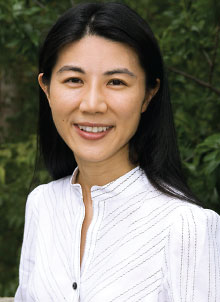The Lonely Society: Medical Anthropologist Examines Loneliness and Suicide
Abstract
In her examination of suicide websites, Chikako Ozawa-de Silva, Ph.D., saw the expression of a society whose very structures promote a sense of loneliness rather than one of belonging and connection.
Loneliness has emerged in recent years as a topic among public health experts, especially as it relates to the increasing rates of suicide. The term usually conjures up an individual who is isolated, cut off from social contact, alone.
But is it possible for an entire society to be lonely? Is there such a thing as a “lonely society”? Can a society itself breed loneliness?

Medical anthropologist Chikako Ozawa-de Silva, Ph.D., says the factors in Japanese culture that have produced a lonely society are evident in the U.S. and other societies, as well as in developing countries.
Chikako Ozawa-de Silva, Ph.D., a medical anthropologist who began studying suicide in Japan when that country first began to experience a spike in suicides in the late 1990s, believes so. She discussed the phenomenon at the 2020 virtual fall conference “Suicide, Culture and Community,” sponsored by the Erikson Institute for Education and Research at the Austen Riggs Center.
“Based on my long-term ethnographic studies, I came to a realization that what I have been witnessing was not just the loneliness of a single person, or a few people, but the loneliness of a society,” Ozawa-de Silva said. “That is—a type of society that makes people feel uncared for, unseen, and unimportant: the lonely society.”
This phrase is intentionally paradoxical, she said. “Society means people being together and living together, engaging socially. To be in society means to not be alone. But it does not mean that one does not feel alone. There are forms of society that make people feel cared for and connected, that instill in people a sense of belonging, and there are forms of society that do the opposite. Every society is somewhere along the scale, but as societies continue to develop, it is increasingly concerning that they seem to be moving in the direction of the lonely society.”
Ozawa-de Silva, an associate professor of anthropology at Emory University, described her research on a troubling and macabre phenomenon: “suicide websites” that began to attract young Japanese men and women seeking to participate in group suicide. She was led to study the websites following several group suicides that captured the nation’s attention and by the fact that the prevailing explanation for Japan’s sharp rise in suicides—the country’s deep economic downturn in the 1990s—did not seem to fully account for epidemiological facts.
“The spike in suicide was seen as being a problem primarily impacting men in their 40s to 60s, who faced economic uncertainty and unemployment due to the burst of the bubble economy in the early 1990s,” she said. “This picture was imperfect from the beginning. For one thing, the spike in suicides happened not only among working-aged Japanese men, but across multiple age categories, including adolescents, who experienced an increase in suicide of 50% in a single year. Secondly, the narrative of ‘economic stagnation leading to suicide’ did not fit the subjective reports of those who were attempting or dying by suicide; nor did it easily account for entirely new forms of suicide, such as internet group suicide.”
At suicide websites described by Ozawa-de Silva, strangers came together online and then sometimes agreed to meet in person to die by suicide together. “It did not take me long to discover that the problems expressed by suicide website visitors were rarely about unemployment or work conditions; neither were they about depression,” she said. “Rather, the most common themes that emerged were loneliness, a lack of meaning in life, and a lack of feeling needed by others.”
(Ozawa-de Silva has been studying the websites devoted to suicide since the early 2000s, when the phenomenon of internet suicide began to gain national attention. In 2006, many of the suicide websites began regulating the behavior and deleting visitors’ personal information.)
The case of a young woman in her 20s who died with a man she had just met over the internet was illustrative. She stated in her will: “It’s sad to die alone. It could have been anyone.” Another website visitor stated: “I no longer wish to suffer. But I am too afraid to die alone. Is there anyone who wishes to die with me?”
Ozawa-de Silva said the distinctive types of mental pain and existential angst expressed by visitors on suicide websites included the following:
Severe loneliness to the point of feeling too lonely to die alone and wanting others with whom to die.
An absence of ikiru imi (‘‘meaning in life’’).
A feeling of not being needed.
An absence of social connections and sense of belonging.
“Since the cause of much of the pain expressed by suicide website visitors is loneliness and a lack of social connection, there is a wish not only to escape the pain of this life, but also to escape the pain of loneliness and disconnection,” Ozawa-de Silva said. “Dying with another person serves both purposes.”
She added, “A lonely society is not just one where a very high number of people within it feel lonely—it is also one where the people do not feel taken care of and cared for by society as a whole and where the structures of society promote a sense of loneliness rather than one of belonging and connection.
“But Japan is not the only country in this situation. The epidemic of loneliness and the social conditions that promote it are widespread. ... The same trends can now be seen in the U.S., Europe, and elsewhere. As developing countries struggle to catch up with developed ones, the same worrying social trends are emerging.” ■



